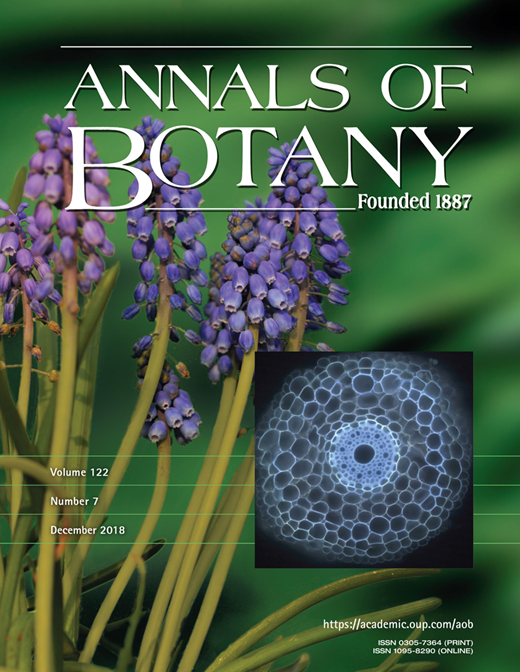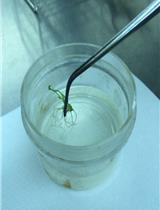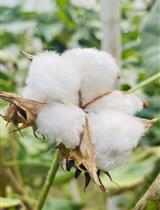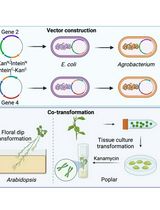- EN - English
- CN - 中文
Stable Transformation of Arabidopsis thaliana Cell Suspension Cultures: A Case Study for the Overexpression of The COI1 Receptor
拟南芥细胞悬浮培养的稳定转化:COI1受体过度表达的案例研究
发布: 2021年01月05日第11卷第1期 DOI: 10.21769/BioProtoc.3880 浏览次数: 5749
评审: Naomi NakayamaTegan M. HaslamNguyen Hoai NguyenAnonymous reviewer(s)
Abstract
Cell suspension cultures have been studied for decades to produce natural molecules. However, the difficulty in generating stably transformed cell lines has limited their use to produce high value chemicals reproducibly and in elevated quantities.
In this protocol, a method to stably transform and maintain Arabidopsis cell suspension cultures is devised and presented in detail. Arabidopsis cell cultures were directly transformed with A. tumefaciens for the overexpression of the CORONATINE INSENSITIVE 1 (COI1) jasmonate receptor. Cell cultures were established after transformation and continuously maintained and tested for the overexpression of COI1. The protocol was also previously used to silence Arabidopsis peroxidases and allows for long term maintenance of transformed cells. Details on culture maintenance, both in liquid and solid media are provided, alongside with evidence of protein expression to confirm transformation.
The system described provides a powerful tool for synthetic biology to study signaling independent of developmental control and to obtain metabolites of interest for the biotechnological and medical sectors.
Background
Plant cell suspension cultures provide a feasible alternative for the production of plant secondary metabolites and the study of dedifferentiated tissue (Wu and Ge, 2004; Lee et al., 2010). Interest in their use has been increasing for decades as they can offer continuous production systems for high-value biotechnological products for human use. There is a wide variety of cell cultures producing high amounts of secondary metabolites of commercial and industrial interest such as anthocyanins, betalains, flavourings, steviosides, among others (Rao and Ravishankar, 2002).
The lack of significant success for plant cell cultures in becoming regularly used for commercial purposes could be attributed in part to the failure of the dedifferentiated cell lines to produce the desired product with the same characteristics found in the organs of parent plants. The use of modern molecular biology and synthetic biology techniques opens the possibility to genetically improve cell lines and plants to enhance metabolite production (Davies and Deroles, 2014).
Methyl jasmonate (MeJA), jasmonyl-isoleucine (JA-Ile) and Jasmonic acid (JA) are collectively referred to as jasmonates (JAs), and they are involved in the regulation of many developmental processes and defense mechanisms in vascular plants (Pauwels et al., 2008, Pérez-Salamó et al., 2019). JA signaling involves ubiquitination of specific target proteins by the SCFCOI1 complex and their subsequent degradation by the 26S proteasome (Thines et al., 2007).
Bömer et al. (2018) has reported the stably transformed Arabidopsis thaliana cell suspension cultures with an epitope-tagged COI1-overexpressing construct (Devoto et al., 2002) to analyze the effects of JA signaling on cell growth and the production of cell wall proteins and metabolites. In that study, a stable transformation of Arabidopsis cell suspensions was successfully achieved and validated. Changes in the primary metabolism of the transformed cell suspensions were observed. The overexpression of COI1 reinforced its role in mediating defense responses after increasing levels of Oligogalacturonide oxidase 1, beta-Glucosidase/endoglucanases and Polygalacturonase inhibiting protein 2. Furthermore, it affected the availability of metabolites such as beta-alanine, threonic acid, putrescine, glucose and myo-inositol, providing a connection between JA-Inhibited growth and stress responses (Bömer et al., 2018).
The protocol described here was initially devised by O’Brien et al. (2012) to silence Arabidopsis peroxidases adapting a transient transformation system from Ferrando et al. (2000). The gene insertion was mapped by O’Brien et al. (2012) (two independent lines generated, each with a single insertion, thus homogenous cell cultures were obtained). The construct used in this work was prepared and used by Devoto et al. (2002) to transiently overexpress the CORONATINE INSENSITIVE 1 (COI1) JAs receptor (35S:: COI1::HiA). Stable transformation with the same construct was successfully achieved by Bömer et al. (2018). Stably transformed Arabidopsis cell cultures, generated by using this protocol, have been maintained since O’Brien et al. (2012) and Bömer et al. (2018) were published. The fully detailed protocol is presented here.
Materials and Reagents
Petri Dishes (90 mm), Thermo ScientificTM SterilinTM Standard (Fisher Scientific, catalog number: 11389273 )
FisherbrandTM L-Shaped Cell Spreaders (Fisher Scientific, catalog number: 15615467 )
MicrospecTM Sterile Plastic Inoculation Loops (Fisher Scientific, catalog number: 15792105 )
Micropore 1.25 cm x 10 cm tape rolls (Medical World Group, catalog number: MA1530-125 )
15 ml sterile Falcon tube (Sarstedt, catalog number: 64554002 )
50 ml sterile Falcon tubes (Sarstedt, catalog number: 62547004 )
Spectrophotometer 10 x 10 x 45 cuvettes (Greiner Bio-One, catalog number: 61301 )
200 ml glass Erlenmeyer flask covered with doubly folded aluminium cap
200 µl yellow, ultra-point graduated tip (StarLab, catalog number: S1113-1006 )
1,000 µl blue, ultra-point graduated tip (StarLab, catalog number: S1111-6001 )
45 µm sterile disposable filters (Sarstedt, catalog number: 831826 )
5 ml sterile disposable syringe (BD Emerald, catalog number: 307731 )
1.5 ml Eppendorf microfuge tubes (Greiner Bio-One, catalog number: 616 201 )
Light tubing (Polylux XL, catalog number: F30W/840 )
Arabidopsis ecotype Landsberg erecta (Ler) cell suspension cultures (obtained originally from the laboratory of the late Prof Tony Slabas and now maintained by the Devoto laboratory at RHUL and by Dr Steve Chivasa laboratory, University of Durham)
Agrobacterium tumefaciens GV3101 containing vector pBin19PLUS (Van Engelen et al., 1995) with the intron-tagged COI1::HiA construct (Devoto et al., 2002)
Tryptone. Peptone from casein (Merck, catalog number: VM944113 749 )
Yeast extract (VWR, catalog number: 1.03753.0500 )
CaCl2 (Sigma, catalog number: C1016-100G )
NaOH (Sigma, catalog number: 221465-500G )
Agar-agar ultrapure (VWR, catalog number: 1.01613.1000 )
Phyto-agar (Melford, catalog number: P1003 )
Gentamicin sulfate salt (Sigma, catalog number: G1264-250MG )
Kanamycin sulphate from Streptomyces kanamyceticus (Sigma, catalog number: K1377 )
Rifampicin (Sigma, catalog number: R8626-1G )
Timentin [Ticarcillin/Potassium Clavulanate Mixture 15:1 Ratio], 5 Grams (Melford Laboratories Ltd., catalog number: T36000-5.0 )
LS Media & Vitamins (Duchefa, catalog number: L0230.0050 )
Sucrose (Sigma, catalog number: 84100 )
Naphtalene acetic acid (Sigma, catalog number: N1641 )
Kinetin (Sigma, catalog number: K3253 )
96-99% Ethanol (VWR, catalog number: 20821.33 0)
LS media (see Recipes)
TY media and agar (see Recipes)
1 M NaOH (see Recipes)
Gentamicin 50 mg/ml (see Recipes)
Kanamycin 50 mg/ml (see Recipes)
Rifampicin 25 mg/ml (see Recipes)
Timentin 160 mg/ml (see Recipes)
Equipment
200 µl Micropipette (Gilson)
1,000 µl Micropipette (Gilson)
10 ml beaker
Erlenmeyer flasks
Magnetic stirring bar
Plant Shaker Incubator (Bottmingen Infurs, model: CH-4103 )
Plant Incubator (Sanyo, model: MLR-352-PE )
Bacterial Shaker Incubator (New Brunswick Scientific, model: Innova 4000 )
Bacterial Incubator (Memmert)
Biophotometer (Eppendorf, model: 6131 01139 )
Centrifuge (Eppendorf, model: 5810R )
Vortex (Spinmix, model: SGP-205-010X )
Laminar flow hood (Bassaire, model: AH191 )
pH meter (HANNA Instruments, model: pH210 )
Magnetic stirrer (Nickel Electro Ltd., model: MSU-1 )
Procedure
文章信息
版权信息
© 2021 The Authors; exclusive licensee Bio-protocol LLC.
如何引用
Diaz Sanchez, E. K., O’Brien, J. A., Pérez-Salamó, I., Krasauskas, J., Bömer, M. and Devoto, A. (2021). Stable Transformation of Arabidopsis thaliana Cell Suspension Cultures: A Case Study for the Overexpression of The COI1 Receptor. Bio-protocol 11(1): e3880. DOI: 10.21769/BioProtoc.3880.
分类
植物科学 > 植物转化 > 农杆菌介导的转化方法
细胞生物学 > 细胞分离和培养 > 转化
您对这篇实验方法有问题吗?
在此处发布您的问题,我们将邀请本文作者来回答。同时,我们会将您的问题发布到Bio-protocol Exchange,以便寻求社区成员的帮助。
Share
Bluesky
X
Copy link












